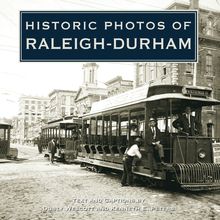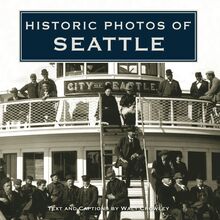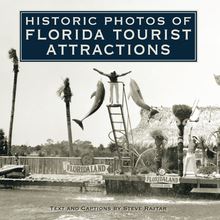Historic Photos of Toledo , livre ebook
175
pages
English
Ebooks
2007
Vous pourrez modifier la taille du texte de cet ouvrage
Obtenez un accès à la bibliothèque pour le consulter en ligne En savoir plus
Découvre YouScribe en t'inscrivant gratuitement
Découvre YouScribe en t'inscrivant gratuitement
175
pages
English
Ebooks
2007
Vous pourrez modifier la taille du texte de cet ouvrage
Obtenez un accès à la bibliothèque pour le consulter en ligne En savoir plus
Publié par
Date de parution
01 juin 2007
Nombre de lectures
1
EAN13
9781618586933
Langue
English
Poids de l'ouvrage
5 Mo
From a city that boasts itself as the "Crossroads of America," has the nation's third largest rail hub, 15th busiest air cargo hub, and one of the busiest ports in the Great Lakes, Historic Photos of Toledo is a photographic history collected from the areas top archives. With around 200 photographs, many of which have never been published, this beautiful coffee table book shows the historical growth from the mid-1800's to the late 1900's of the "Glass City" in stunning black and white photography.
The book follows life, government, events and people important to Toledo history and the building of this unique city. Spanning over two centuries and two hundred photographs, this is a must-have for any long-time resident or history lover of Toledo!
Publié par
Date de parution
01 juin 2007
Nombre de lectures
1
EAN13
9781618586933
Langue
English
Poids de l'ouvrage
5 Mo
HISTORIC PHOTOS OF
TOLEDO
T EXT AND C APTIONS BY G REGORY M. M ILLER
The passengers on this train rolling across the New York Central Bridge about 1896 would have an excellent view of the developing skyline of Toledo. Church spires still predominated before the turn of the century, but the era of the skyscraper would emerge during the next decade. The structure near the center of the bridge that looks like a ship is actually the mechanism that pivoted the bridge to allow ships to pass through.
HISTORIC PHOTOS OF
TOLEDO
Turner Publishing Company
200 4th Avenue North Suite 950
Nashville, Tennessee 37219
(615) 255-2665
412 Broadway P.O. Box 3101
Paducah, Kentucky 42002-3101
(270) 443-0121
www.turnerpublishing.com
Historic Photos of Toledo
Copyright 2007 Turner Publishing Company
All rights reserved.
This book or any part thereof may not be reproduced or transmitted in any form or by any means, electronic or mechanical, including photocopying, recording, or by any information storage and retrieval system, without permission in writing from the publisher.
Library of Congress Control Number: 2007923672
ISBN-10: 1-59652-343-3
ISBN-13: 978-1-59652-343-2
Printed in the United States of America
07 08 09 10 11 12 13 14-0 9 8 7 6 5 4 3 2 1
C ONTENTS
A CKNOWLEDGMENTS
P REFACE
T HE F UTURE G REAT C ITY OF THE W ORLD (1870-1899)
F ROM P ORT T OWN TO F ACTORY T OWN (1900-1929)
D EPRESSION AND W AR (1930-1949)
T HE P OSTWAR D ECADES (1950-1975)
N OTES ON THE P HOTOGRAPHS
This aerial view features both sides of the river, with a busy Toledo Marine Terminal at center-left. The opening of the St. Lawrence Seaway in 1959 provided a short boom in Great Lakes shipping, but by the mid 1970s the Marine Terminal had closed (it has since been reborn as the Docks).
A CKNOWLEDGMENTS
The photograph collection of the Local History Department of the Toledo-Lucas County Public Library first came to the attention of the kind folks at Turner Publishing through its presence on the internet. Monies to digitize this collection were provided by the DaimlerChrysler Foundation, the City of Toledo, and the Library Legacy Foundation of the Toledo-Lucas County Public Library.
I would like to acknowledge the other staff members in the Local History Department-Michael Lora (manager), Donna Christian, Ann Hurley, Irene Martin, and Laura Voelz-for their assistance in completing this book.
-------
For my three children, Katie, Martha, and Daniel and most of all, for my wife, Glenda, without whom my life would not be complete
P REFACE
Toledo has thousands of historic photographs that reside in archives, both locally and nationally. This book began with the observation that, while those photographs are of great interest to many, they are not easily accessible. During a time when Toledo is looking ahead and evaluating its future course, many people are asking, How do we treat the past? These decisions affect every aspect of the city-architecture, public spaces, commerce, infrastructure-and these, in turn, affect the way that people live their lives. This book seeks to provide easy access to a valuable, objective look into the history of Toledo.
The power of photographs is that they are less subjective than words in their treatment of history. Although the photographer can make decisions regarding subject matter and how to capture and present it, photographs do not provide the breadth of interpretation that text does. For this reason, they offer an original, untainted perspective that allows the viewer to interpret and observe.
This project represents countless hours of review and research. The researchers and writer have reviewed thousands of photographs in numerous archives. We greatly appreciate the generous assistance of the individuals and organizations listed in the acknowledgments of this work, without whom this project could not have been completed.
The goal in publishing this work is to provide broader access to this set of extraordinary photographs that seek to inspire, provide perspective, and evoke insight that might assist people who are responsible for determining Toledo s future. In addition, the book seeks to preserve the past with adequate respect and reverence.
With the exception of touching up imperfections caused by the damage of time and cropping where necessary, no other changes have been made. The focus and clarity of many images is limited to the technology and the ability of the photographer at the time they were taken.
The work is divided into eras. Beginning with some of the earliest known photographs of Toledo, the first section records photographs through the end of the nineteenth century. The second section spans the beginning of the twentieth century up to the eve of the Great Depression. Section Three moves from the depression to World War II and the years immediately following. The last section covers the postwar decades to 1975.
In each of these sections we have made an effort to capture various aspects of life through our selection of photographs. People, commerce, transportation, infrastructure, religious institutions, and educational institutions have been included to provide a broad perspective.
We encourage readers to reflect as they go walking in Toledo, strolling through the city, its parks, and its neighborhoods. It is the publisher s hope that in utilizing this work, longtime residents will learn something new and that new residents will gain a perspective on where Toledo has been, so that each can contribute to its future.
Todd Bottorff, Publisher
By 1872, the Western Manufacturing Company produced sashes, doors, and blinds for use in the houses that were being built in the Midwest. The standardization of these building components, combined with the new balloon frame method of construction, made possible the lower prices for housing that followed, which enabled working families to acquire their own home.
T HE F UTURE G REAT C ITY OF THE W ORLD
(1870-1899)
Toledo, like many cities in the Midwest, was populated with a number of settlers known as boomers. These men tried to persuade others to invest and settle in their city, because its geographic location, in their view, would guarantee its success. The most prominent of these men in Toledo was named Jesup (or Jessup-he spelled it both ways) Wakeman Scott.
Scott produced a slim volume while he worked as editor and publisher of the Toledo Blade called A presentation of causes tending to fix the position of the future great city of the world in the central plain of North America. The crux of Scott s argument was that Toledo s location at the western end of one of the Great Lakes meant that it was bound to become a trading center for much of mid America. Scott had been making this argument since arriving in Toledo about thirty years earlier.
Others were making similar arguments about a settlement in a marsh at the southwestern edge of Lake Michigan that reeked of rotting wild onions each fall. Chicago s location at the western end of the Great Lakes system, rather than at the western end of a Great Lake, proved to be too much of an advantage. Although Toledo may not have become the Future Great City of the World, as prophesied by Jesup Scott, it did become an important regional trade center after the Civil War, and an important industrial city in the years before the opening of the twentieth century.
The photographs that follow illustrate Toledo s rise to prominence, and the struggles that were sometimes necessary to turn a former swamp into a modern city.
Toledo s location near the mouth of the Maumee River made it an attractive shipping hub, both to ship raw goods east and to distribute manufactured goods in its trading area. This location on the Maumee also made it an attractive terminus for canal builders.
This is Superior Street near the corner of Adams Street, around 1877. The congregation of St. Paul Methodist-Episcopal, shown at center, later built a church on Madison Avenue. Superior and Adams streets are today at the heart of downtown, which has not seen single family dwellings for upwards of a hundred years. In 1877, however, Toledo was a walking city-most destinations could be reached by foot.
The Maumee River was vital to the economic health of the city, but it could also be a destructive force. Shown here is an 1883 ice gorge. After a hard winter, sudden thaws can cause ice on the Maumee River to break up; these ice floes then become jammed against bridges across the river. In earlier times, the combined force of the ice and water could damage or even destroy a bridge.
Like much of the rest of the nation, after the Civil War Toledo attempted to attract manufacturing concerns. In 1878, the city succeeded in attracting the Milburn Wagon Works to Auburndale, a newly established suburb, partly financing the construction of a factory. By the mid 1880s, Milburn claimed to be the largest wagon manufacturer in the world. This success, and the discovery of natural gas near Findlay, encouraged a second manufacturing company, the New England Glass Company, to relocate to Toledo in 1888.
Ice gorges not only damaged bridges in 1883, they also backed up water in sufficient quantity to flood downtown-especially along Water Street. The number of bridges crossing the Maumee during this earlier time created more places for ice floes to jam against, causing the river to back up. Today, because of the flatness of the landscape in Toledo and Northwest Ohio, the Maumee rarely floods in Toledo proper-flooding takes place farther upriver.
The sixth-grade class at Franklin School in 1887 poses for the photographer. Franklin was located in East Toledo, on Elm between 3rd and 4th streets. By 1887 Toledo had a number of grammar schools, as well as a high school, constructed in 1853. Besides the public school system, Toledo s growing Roman Catholic population also supported grammar schools at many of the parish














